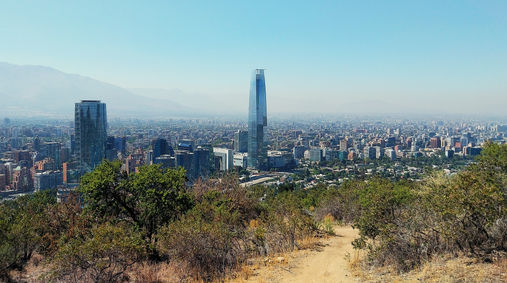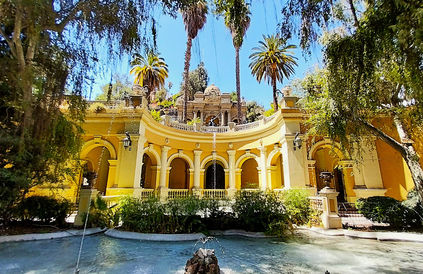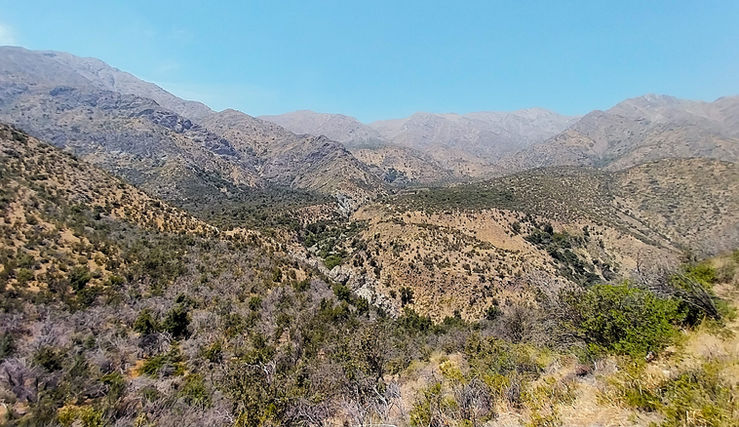
Santiago
Chile
Santiago was the final stop on our whirlwind South American adventure. Most of the 4 days we spent here involved exploring the various neighbourhoods across the enormous city. Staying in the Providencia district turned out to be a wise choice, full of modern cafes and restaurants and with easy access to the other barrios we wanted to visit.
Parque Metropolitano is the largest urban park, not just in Santiago but also in the whole of the Americas. It offered something for pretty much everyone - for me, it was hills. I devoted an entire morning climbing up and down the small peaks to lookouts that covered almost every inch of the city. Disappointingly, pollution and heat haze blurring most of the views. The main attraction within the park was Cerro San Cristobal, which was topped with a giant statue of the Virgin Mary. I climbed up the steps to its base, but the incessant biblical messages being blasted out of a speaker in Spanish lead to me making a hasty descent.
The Museum of Memory and Human Rights was never going to be a cheerful place. Three floors were dedicated to Pinochet's rise to power in Chile, the atrocities that occurred under his dictatorship and his eventual demise. Although the majority of displays were in Spanish, there was enough English to understand the brutality that transpired. Videos of survivors describing the methods of torture they endured were particularly harrowing.

Although there were several long, technical hikes just outside of Santiago, they weren’t accessible via public transport. Instead, I settled for a trek closer to the city: Cerro Manquehue. The hill can be seen from miles around, sticking several hundred metres up into the air. It was only a short hike, but what it lacked in distance it made up for in intensity.
Being a weekend meant I wasn't alone most of the time, but even with masses of people and frequent signs I still managed to veer off the trail more than once. In the end it didn't matter - all paths led up. The first 1.5 km were straightforward, slowly climbing up the exposed, cacti-covered slopes. The last 900 metres, though, were anything but easy. Not only did the gradient increase exponentially, the surface was a nightmare. A thin layer of sandy gravel covered the bare earth, and every step, despite appearing solid, had me sliding back down again. The sections of loose rocks were no better. Throwing in a few switchbacks would have helped, rather than leading vertically uphill. I spent much of the time using my arms to support myself, wishing there were branches to hold onto. I could see why everyone else had hiking poles.
Thankfully, the summit was well worth it, with 360-degree views around the mountain. Again the city was shrouded in smog, but it was a much better vantage point than Parque Metropolitano. In the local Mapuche language, Manquehue means 'place of condors', and I was lucky enough to spot a lone condor flying overhead. I watched it for some time, postponing the descent for as long as possible.
Going down wasn't fun. I tiptoed from one inch of stable ground to the next, trying to avoid the precarious gravel. I skidded repeatedly yet somehow managed to stay upright most of the time (there were a couple of spills). In the end, it took me over 2 hours to hike less than 5 km. I was disgustingly filthy but I returned in one piece, which was all that mattered.

Walking through the centre of Santiago on a weekend in the middle of summer was like entering a ghost town. The streets were eerily empty, most of the stores were closed, and the tourist attractions were free of tourists. Neoclassical buildings lined the streets, but most weren't extravagant or over the top. In the tree-filled centre square, Plaza de Armas, a man shouted passionately about some issue in Spanish through a megaphone, while kids swam in the fountain. On one side was the Metropolitan Cathedral, appearing relatively understated compared to many of the churches we had seen, while on another stood the Museum of National History. I wandered through the museum’s collection to find that not a single sign or information board was in English. All I could do was stare at portraits of pompous-looking people who lived centuries ago, old-fashioned household items and remnants of prior battles. I can't say I learnt much.
Cerro Santa Lucia is an old fort situated on a small hill in the city centre. Like the rest of the city, it was virtually deserted. Wide, leafy paths zigzagged in a maze-like fashion around the slopes, passing by fountains, a chapel and numerous lookouts. Eventually I reached the top of the old fort tower, giving me panoramic views across Santiago. As the tower was quite short, the haze didn’t have as much of an impact compared to previous viewpoints, but the scenery overall wasn't as impressive. On the upside, it was a peaceful escape from the noise of the traffic below.

It wasn't surprising that there was a large crowd of people milling about the entrance to the park on a hot, sunny Sunday. While my target was a 25-metre-high waterfall about 8.5 km away, many others had come just to take a dip in the river halfway along the trail. With the sun blazing down and there being no escape from the heat, I didn’t blame them.
There were 2 routes from the start point, and I randomly chose the southern path. It climbed high above the valley before edging along the side of the mountain, with the sprawling city laid out behind me. Shade was non-existent, the only flora being cacti and other thorny plants (I was covered in scratches by the end). The trail was well signed and straightforward to follow, made even easier by the masses of people around me, guiding the way.
After a few kilometres the path intersected with the northern route, where there were numerous access points to the water. For hundreds of metres, people occupied every inch of the riverbanks or sat in the gentle rapids and cascades. I continued on until I found myself at a wide river crossing where more locals were bathing. I had no idea how to cross the water without my feet becoming soaked, so I waited and watched how other hikers made it over. Straight through the river seemed to be the best, and possibly only, option. As soon as I reached the other side, my feet squelching in my boots, I went to carry on up the path but was stopped by a ranger. Apparently, the rest of the trail was closed today due to the high temperatures, and this was as far as I could go. It would have been helpful to know this prior to starting out, or at least before I drenched my shoes in the river.
Dejectedly, I returned the way I came, although this time I chose the northern path to mix things up. While studying the map on my phone, I noticed another trail that appeared to take a slightly longer route to the falls. When I reached the turn off for this path, I found it was well made and not difficult to follow. However, there were no signs indicating it would lead me to my destination (signs were posted at every intersection in the rest of the park). It wasn't on the official park map but, as no one was stopping me, I decided to take it and hope for the best.
The track was steep and slippery, but blissfully free of the hordes congesting the main trail. I could have counted the number of people I passed on 2 hands. It took an eternity before I finally reached the base of Apoquindo Waterfall, a long drop of water plunging over a cliff into a small pool at my feet. I sat in the spray while eating lunch, happily cooling off and washing the dirt from my arms and legs. Only a handful of others were here, which was perfect. I didn’t want to imagine what it would have been like if the main path was open.
Somehow I didn't melt into a puddle or burn to a crisp in the midday heat on the way back (I did spend the rest of the day trying to rehydrate and cool myself down after spending over 5 hours in the intense sunlight. A few more trees wouldn't have gone astray). I had no idea why the alternate path I took was open when the main one was closed, but I was thankful my efforts paid off and I was able to reach the waterfall in the end.

After spending almost 7 months in South America, the time had come to return home and face reality again. Overall, the trip was everything we wanted and more, and we hoped that one day we would have the opportunity to see what the rest of the continent had to offer.








































